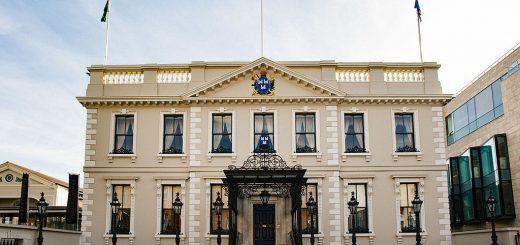Admiral Tryon’s Ghost
Following an eight year search, on 22nd August 2004, Christian Francis of Lebanon Divers found the wreck of HMS Victoria near Tripoli. Standing vertically with her bow and the first 30m of her length buried in the seabed, she was the victim of naval blunder and her sinking in 1893 is directly linked to reports of an apparition being witnessed. This experience has since been explained away and debunked but for many years it was considered an important piece of evidence, hence earning this story a place in paranormal history.
The Ship
 HMS Victoria (originally planned to be called Renown, but changed to celebrate Queen Victoria’s Golden Jubilee) was one of two Victoria Class Battleships (the other being the HMS Sans Pareil) and the Flagship of the largest, most powerful fleet in the world, the British Mediterranean Fleet. Built by Armstrong Whitworth and launched on 9 April 1887 she was 340 foot long with a displacement of 11,020 tons. She was the first battleship to use the Humphreys & Tennant triple expansion steam engine and could reach 17.3 knots. She had 18 inch armour and could take a crew of 430, though this was increased to 583 whilst acting as the Flagship. Her main armament was two 16.25 inch guns (in a single front turret), backed up by one 10 inch gun, twelve 6 inch guns and twelve 6 pound guns. It is probably the weight of this heavy forward turret and her powerful engines that resulted in her nose diving to beneath the waves and being vertically embedded so deeply in mud. Even though the last ship battle to be won by ramming the enemy vessel was in 1879, Victoria was equipped with a ram and the orientation of her guns were forward facing so that they could target the enemy vessel before her ram tore into them. Though this sounds impressive, it means the Victoria was not a well rounded ship and would not have been as much use in gunnery warfare, which is of course how later ships were won.
HMS Victoria (originally planned to be called Renown, but changed to celebrate Queen Victoria’s Golden Jubilee) was one of two Victoria Class Battleships (the other being the HMS Sans Pareil) and the Flagship of the largest, most powerful fleet in the world, the British Mediterranean Fleet. Built by Armstrong Whitworth and launched on 9 April 1887 she was 340 foot long with a displacement of 11,020 tons. She was the first battleship to use the Humphreys & Tennant triple expansion steam engine and could reach 17.3 knots. She had 18 inch armour and could take a crew of 430, though this was increased to 583 whilst acting as the Flagship. Her main armament was two 16.25 inch guns (in a single front turret), backed up by one 10 inch gun, twelve 6 inch guns and twelve 6 pound guns. It is probably the weight of this heavy forward turret and her powerful engines that resulted in her nose diving to beneath the waves and being vertically embedded so deeply in mud. Even though the last ship battle to be won by ramming the enemy vessel was in 1879, Victoria was equipped with a ram and the orientation of her guns were forward facing so that they could target the enemy vessel before her ram tore into them. Though this sounds impressive, it means the Victoria was not a well rounded ship and would not have been as much use in gunnery warfare, which is of course how later ships were won.
The Man
Vice-Admiral Sir George Tryon KCB (4 January 1832- 22 June 1893) was the commander of HMS Victoria and the Mediterranean Fleet. It was Admiral Tryon who gave the fatal order that resulted in the sinking of HMS Victoria and his ghost that was said to appear in his London home at the exact moment of his death as he went down with his ship. Admiral Tryon had joined the Royal Navy in 1848 and was a veteran of the Crimea and the Abyssinian Campaign. He had served aboard many Royal Navy ships including HMS Warrior, HMS Surprise, HMS Raleigh and HMS Monarch and was known as a strict disciplinarian and for having a reputation for being a daring but skillful ship handler. He developed the TA system with which complex ship maneuvers could be communicated with minimal signaling and relying on the individual Captains using their initiative. After the fatal sinking of HMS Victoria on 22 June 1893 the TA system side lined.
The Accident
 22 June 1893, the Mediterranean Fleet was on maneuvers near Tripoli. It was a clear day and from shore the planned maneuvers were being watched by a large crowd, including many senior military officers. Vice-Admiral Sir George Tryon had kept the nature of the maneuvers secret so as to train his ships Captains how to handle situations they were not unprepared for. The Fleet was formed into two divisions, each travelling in a column. The two columns were travelling parallel to each other with HMS Victory and Vice-Admiral Sir George Tryon at the head of the first divisions column and the second led by HMS Camperdown and the fleets deputy commander Rear-Admiral Hastings Markham.
22 June 1893, the Mediterranean Fleet was on maneuvers near Tripoli. It was a clear day and from shore the planned maneuvers were being watched by a large crowd, including many senior military officers. Vice-Admiral Sir George Tryon had kept the nature of the maneuvers secret so as to train his ships Captains how to handle situations they were not unprepared for. The Fleet was formed into two divisions, each travelling in a column. The two columns were travelling parallel to each other with HMS Victory and Vice-Admiral Sir George Tryon at the head of the first divisions column and the second led by HMS Camperdown and the fleets deputy commander Rear-Admiral Hastings Markham.
At 15.00 Victoria signaled the fleet. The two columns were to turn toward each other through 180 degrees so that they would continue going back the way they had come. In effect a big U-turn. The columns would have to be at least 2000m apart to safely do the maneuver. They could probably have managed it with 1500m. They were actually about 1000m apart when the order was given. As this was a maneuver with no set signal available, Tryon sent each division a message:
“Second division alter course in succession 16 points to starboard preserving the order of the fleet.” “First division alter course in succession 16 points to port preserving the order of the fleet.”
Markham saw the order was dangerous and delayed acknowledging it with his own flag signal. Annoyed Tryon urged him on with “What are you waiting for?”. Publically rebuked by his commanding officer, Markham gave the order for his ships to turn and many of the officers were expecting Tryon to be planning another maneuver that would avoid the collision he had set in motion. It never came.
Captain Maurice Bourke of HMS Victoria requested permission to change course three times from Tryon, but the Admirals’ realization and frantic ordering to go astern and start reversing came to late.
HMS Camperdown was a 10,600 ton Admiral Class Battleship armed with it’s own ram. She hit HMS Victoria 4m under the waterline, punching through her armour and piercing her 3m deep. Immediately the orders to reverse took effect and the Camperdown pulled her ram out of Victoria, which actually allowed all the sea water to enter the stricken flagship through the 9 m² wound before her water tight doors could be sealed. Within five minutes the forecastle and the heavy front turret were underwater, Thirteen minutes after impact Victoria capsized and then quickly sank.
HMS Camperdown was severely wounded but survived. Her ram was nearly torn off and water flooded her bows, but her crew managed to stop the flooding. Camperdown would require three months in dry dock for repair. Aboard HMS Victoria no order to abandon ship was given until the last minute. Tryon stayed on the bridge as Victoria sank. 358 people lost their lives due to the accident.
This was a major incident. The Royal Navy had lost the flag ship of it’s premier fleet, a high ranking Admiral and over 300 service men due to a naval blunder that took place during peace time. All this on a calm sea, in good weather and to a capacity audience. Not to mention the damage to HMS Camperdown. Captain Maurice Bourke survived and was brought before courts martial. But he was found innocent of any wrong doing as he was obeying the orders of Admiral Tryon, his senior officer, who was present on the bridge with him.
The Ghost?
According to tradition, as the HMS Victoria sank and Admiral Tryon died, he appeared at his home in Eaton Square near Belgravia (some sources say it was Eaton Place and others Belgrave Square). Lady Tryon was entertaining guests and although she did not see her husband, many of her guests were supposed to have witnessed the Admiral appear in the drawing room in full naval uniform. Unfortunately however there is no truth to the story and it is a modern myth that has been repeated time and time again.
Why did Tryon give such an order? One suggestion is that he got confused and only meant the ships to turn 90 degrees, for which they would have had ample room. Another was that he was receiving medication for a leg ulcer and this could have been an opium derivative.
It is worth noting that the ships Executive Officer was Commander John Jellicoe and he was suffering from Malta fever at the time of the incident. Although he was ill he managed to leave his cabin and evacuate from the sinking vessel. Jellicoe eventually became 1st Earl Jellicoe, Admiral of the Fleet and commander of the British Grand Fleet at the Battle of Jutland in WWI.

















Recent Comments